As the New Horizons spacecraft approaches the amazing Pluto system for an historic flyby in July, 2015, it’s inevitable we should discuss whether Pluto is a proper planet or only a “dwarf planet” as the International Astronomical Union (IAU) voted in 2006. The IAU’s definition of a planet says that it must (1) orbit the sun, (2) be large enough to be rounded by gravity, and (3) have cleared out its orbit [by flinging away or absorbing the smaller bodies that once tried to share that orbit]. Pluto meets requirement parts 1 and 2 but not part 3, so it was defined as merely a dwarf planet, and according to the IAU a dwarf planet is not a subcategory of planet  but is a separate category. In my opinion this was a mistake. However, the interest in Pluto’s planethood is a great opportunity to discuss science! So let’s not miss it. Here are nine reasons why Pluto is a planet.
but is a separate category. In my opinion this was a mistake. However, the interest in Pluto’s planethood is a great opportunity to discuss science! So let’s not miss it. Here are nine reasons why Pluto is a planet.
1. Pluto is not that small
When people explain why they think Pluto is not a planet, they say it’s just too small. Neil deGrasse Tyson asks, if Neptune were the size of a Chevy Impala, then what size car would Pluto be? His answer: it would be a matchbox car. Thus, “Pluto had it coming.”
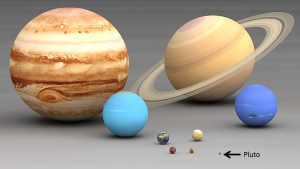
Comparing planet sizes. All are to scale. Credit: leSud. License CC BY-SA 3.0, modified by addition of Pluto.
In my opinion, this favoritism toward larger planets is anthropocentric bias, similar to thinking that planets revolved around the Earth. It turns out the majority of planets are indeed small, and Pluto is in the middle of the size range. Using Mike Brown’s list of probable dwarf planets, keeping all the bodies that are larger than 300 km (because they are probably large enough to be rounded by gravity), it turns out there are 184 bodies in our solar system large enough to be planets. Of these, Pluto is the 17th largest.1 That puts Pluto in the 88th percentile for largest planets! Since we are still discovering smaller planets, its rank is likely to climb to somewhere between the 90th and 95th percentile. That will give Pluto an “A” grade as one of the top planets of our solar system.
But in any case, size is not the essential feature of classification in other branches of science. Let’s look at some examples:
| Classification | Small | Large | Size Factor (mass) |
|---|---|---|---|
| Planets | Kuiper Belt Object 2010GB174 (600x smaller than Pluto) | Jupiter | 95 Million times |
| Mammals | Etruscan Shrew | Blue Whale | 101 Million times |
| Reptiles | Brookesia micra chameleon | Dreadnoughtus schrani dinosaur | 361 Million times |
| Fish | Docypris progenetica | Whale Shark | 4 Billion times |
| Galaxies | Segue 2 | IC 1101 | 15.3 Billion times |
Here are some graphics that help to make this point:
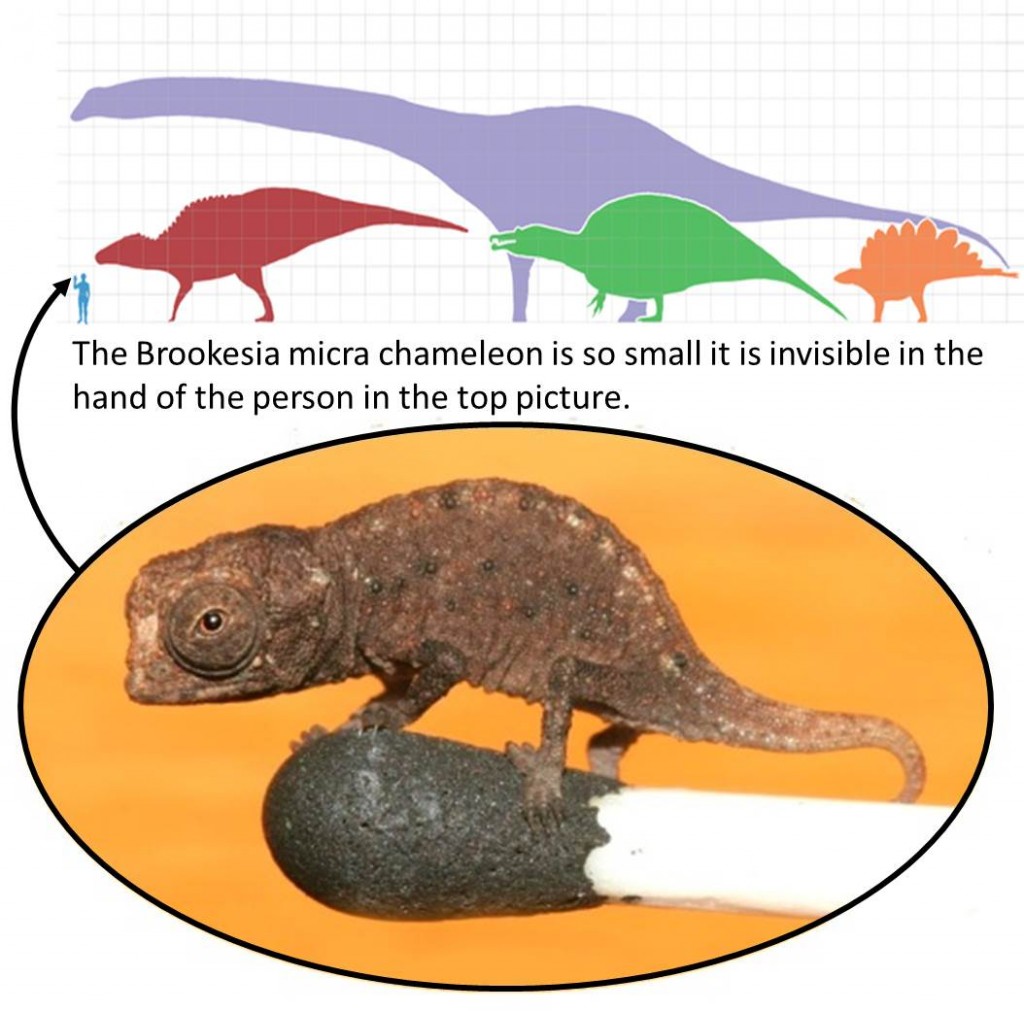
Top credit: Matt Martyniuk. License CC BY-SA 3.0. Bottom credit: Frank Glaw, Jörn Köhler, Ted M. Townsend, and Miguel Vences, license: CC BY 2.5.
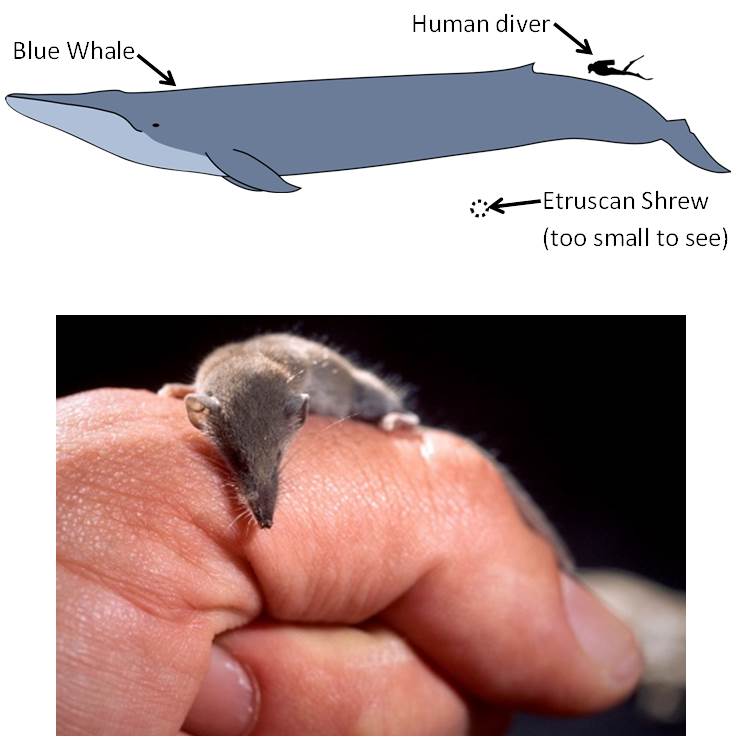
The Etruscan shrew is much tinier than a human finger and is not even visible in the comparison with a blue whale. Top credit: Kurzon. Bottom credit: Trebol-a. License CC BY 3.0.
All these categories have size ranges that are bigger than the range of planets in our solar system. Are planets the only things in nature that aren’t allowed this beautiful diversity?
Pluto is mid-range in the sizes of planets. Returning to Neil deGrasse Tyson’s illustration, a Chevy Impala is actually 64 times longer than a Matchbox Car whereas Neptune’s diameter is only 21 times bigger than Pluto’s, so it turns out Neil’s example exaggerates by a factor of 3. In terms of volume, it exaggerates by a factor of 27. Even if it had exaggerated by a factor of 100,000 it would make no difference in helping the argument against Pluto. Reptiles, mammals, galaxies – so many categories of nature – have size ranges thousands or even hundreds of thousands times larger than the range between Neptune to Pluto.
Pluto is most definitely large enough to be a planet.
2. Pluto is not a comet
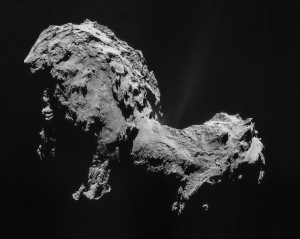
Comet 67P/Churyumov–Gerasimenko photographed by the Rosetta spacecraft. Credit: ESA/Rosetta/NAVCAM, CC BY-SA IGO 3.0.
Neil deGrasse Tyson also says, “Pluto is my favorite comet.” He says that because of Pluto’s ice content, if it were put as close to the sun as the Earth then it would grow a tail. “That’s no kind of behavior for a planet,” he says, “Planets don’t have tails.” Thus, since it behaves like a comet, it must be a comet.
This “Pluto would grow a tail like a comet” meme is factually incorrect – a violation of physics – and unfortunately it’s repeated all over the Internet. It’s even in the Wikipedia article about Pluto. (Wikipedians: go fix that!)
It doesn’t matter that Pluto is partially ice. It’s only about 30% ice (by mass) while the other 70% is rock, but that’s neither here nor there. Planets can be made out of rock, metal, ice, liquid, or even gas. And planets with any of these materials can form a tail if put close enough to a star. We actually do know of some exoplanets that have tails. However, Neil makes a great point that we should classify bodies according to their prototypes. If Pluto were to behave prototypically like a comet, then maybe it should be classified as a comet. But if it behaves prototypically like a planet, then it should be classified as a planet. Let’s look at the physics to see what would really happen if Pluto were put closer to the sun.
Pluto is a fairly large body, massive enough for gravity to pull even rock and ice into its rounded shape. (That’s the geophysical definition of planet, by the way, and everybody agrees that Pluto is that large.) Not only that, it’s got enough gravity to hold an atmosphere, too. The escape velocity of Pluto is 1200 meters per second. For gas to sublimate and fly directly off Pluto to form a tail the way it does from a comet, it would have to leave Pluto’s surface with a temperature of more than 1,300° C, or about 2,500° F. Pluto would need to be hot enough to melt rock before it can form a tail like a comet. Not even Mercury is close enough to the sun to melt rock.
Let’s compare this with the comet being visited by the Rosetta spacecraft. The comet is so small that its gravity can’t pull it into a round shape, and its escape velocity is only about 1 meter per second. Gas leaving the surface of this comet needs to be 1/1000th of a degree above absolute zero in order to fly off and form a tail. And since the surface of the comet is far, far hotter than that, the gas actually does fly off and does form a tail. The reason comets form tails while planets generally don’t is because they are so small. Pluto is a giant compared to comets.
So if you put Pluto near the Earth, the gas will not advect from the surface all the way to space to form a tail. Instead, the sublimating gas will be held down by gravity to form a thickening atmosphere. When enough ice has sublimated and the atmosphere’s pressure is high enough, the methane ice will melt into liquid instead of sublimating into gas, and Pluto will form rivers and oceans of methane, similar to the methane lakes of Titan. It would become an ideal location for life to take root. Comets don’t behave like that.
Pluto couldn’t maintain those conditions forever. Gas escapes from every planet by several mechanisms including Jeans escape, ion pickup, and bulk plasma escape along the tail (all vastly slower than advecting directly out from a comet). Mercury cannot keep an atmosphere so close to the sun, either. Mars’ atmosphere is much thinner now than it was billions of years ago because the gas has mostly escaped. Even Earth has a thin tail of gas flowing away from it. But planet tails are not like comet tails. Their gas only escapes from the upper layer of their atmospheres, from their exospheres, and even just a fraction of that exospheric gas is able to escape so it is very slow. The atmospheres are layered. Comets don’t behave like that.
So using Neil’s argument, but correcting the part about the escape velocity, we should ask if Pluto would be like a comet or like a planet when placed near the sun.
It’s pretty obvious that Pluto would behave like a planet.
3. The IAU definition unfortunately mixes up being with doing
Philosophers wonder whether it is more important to be or to do. According to the graffiti on the wall:

Saying a planet must be round by its own gravity is a part of its being. Saying it must have cleared its orbital neighborhood is a part of its doing. There’s also an implicit requirement that a planet must not be so big that it starts nuclear fusion, because then it would be a star. That’s part of its being. And furthermore, the IAU says a planet must orbit a star instead of going rogue or orbiting another planet. That’s more of its doing. This mixed-up set of being and doing requirements reflects the chaos of human history, because we didn’t understand what planets were in the earliest days of astronomy, and we never said, “let’s just start over and create a completely new system that makes sense.”
Mixing these would be crazy in any other branch of science. Suppose we said that unless a species eats meat, then it’s not a real mammal; it’s just a dwarf mammal. Or consider the tiny chameleon pictured above. It could never clear the alligators out of its neighborhood, so it wouldn’t qualify as a true species of reptile; it’s just a dwarf reptile, and dwarf reptiles are not reptiles. Historical note: at one time the biologists argued whether whales should be classified as mammals or fish. They eventually realized that being a mammal is more fundamental than doing like a fish.
That’s not to say that both being and doing classifications don’t still exist in biology, because they do. Some mammals and some reptiles are classified as carnivores while others are classified as herbivores. Biologists just don’t intermix the doing and being categories into the same classification.

4. The ability to clear an orbit depends on the star, not just the planet
It has been argued that the notion of a planet “clearing out its orbit” is too vague, so it has been made more rigorous by defining the “scattering parameter”. This parameter quantifies the ability of a planet to scatter all the smaller bodies out of its neighborhood. It is calculated as the planet’s mass squared divided by its orbital period, multiplied by another factor that describes the swarm of smaller bodies in its path (which we can consider a constant factor). In our solar system, all the planets with a scattering parameter larger than unity have mostly cleared out their orbits, whereas those with scattering parameters smaller than unity share their neighborhood with a swarm of other bodies that have not been cleared away. So it seems that this scattering parameter really works! Pluto is one of the largest bodies that has a scattering parameter less than unity, and there is a gap of over 4 orders of magnitude between scattering parameter of the weakest major planet (Mars) and the strongest dwarf planet (Pluto). This is shown in the figure, below. Doesn’t this tell us without any doubt that Pluto is not a true planet? Some people certainly think so.

Plot of Scattering Parameter for bodies >300 km diameter in our solar system. Moons are included just for general interest, since they aren’t in orbit directly about the sun so the scattering parameter does not really apply to them. Reference Stern and Levison, “Regarding the Criteria for Planethood and Proposed Planetary Classification Schemes,” Highlights of Astronomy 12, 205—213 (2012).
While it seems simple enough, it gets fuzzy as soon as we consider other solar systems. For one thing, the scattering parameter depends not only on the planet itself, but also on the size of the star it orbits. That’s because the planet’s orbital period is shorter when the star is more massive and vice versa. Let’s consider a couple of examples. One day we will find a body the same size and mass as Saturn’s little moon Tethys but orbiting in the habitable zone of a red dwarf star. That’s not an unlikely scenario: there are billions and billions of red dwarf stars in our galaxy. It turns out that this Tethys twin will have a scattering parameter greater than unity everywhere in that star’s habitable zone. That means Tethys is a major planet when it’s at a red dwarf star.
Some day we will also find a twin of the Earth in the habitable zone of a large, O-type star. Everywhere within that zone, the Earth twin will have a scattering parameter that is two orders of magnitude too small to be a major planet. Sadly, the Earth twin will be classified as only a dwarf planet at that star.
So when we find these worlds, we will make this poster:
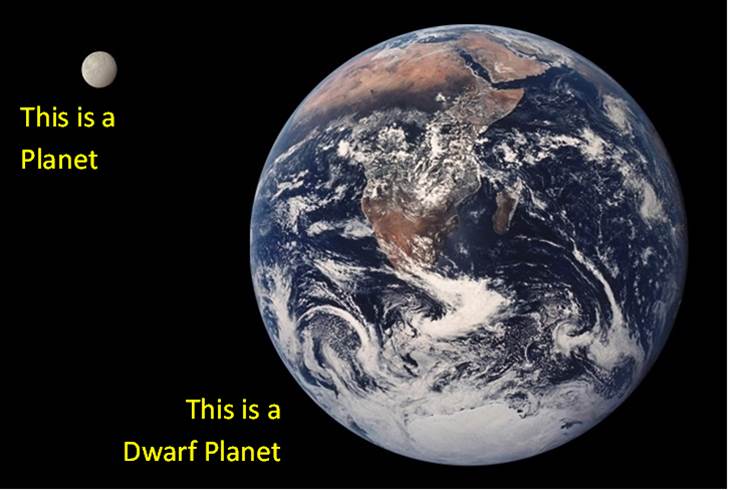
According to the scattering parameter, Tethys would be a major planet in the habitable zone of a red dwarf star, while Earth would be a dwarf planet in the habitable zone of an O-type star.
What if biologists did classification like this? We could ask them, is a dog a mammal? They might say, well, it depends upon the island where the dog lives. If it’s a big island that supports a population of tigers, then the dog is just a dwarf mammal, and dwarf mammals are not mammals. But if it swims to a smaller island that doesn’t support tigers, then it can dominate the island and then it’s not a dwarf mammal any more. Then it is a true mammal. (Hmmm…)
Pluto, being a medium-sized planet, would clear its neighborhood around our sun if it were at the orbit of Venus or Mercury. It would almost do so if it were at the orbit of the Earth. It would definitely do so if it were in the habitable zone of any star slightly less luminous than our own, which includes the vast majority of stars in the universe. Therefore, if there is life beyond the Earth, one could argue that it is likely to be found on a medium-sized planet like Pluto. (And by the way: in terms of percentile, Pluto has one of the highest scattering parameters of all the planet-sized bodies in our solar system.)
The scattering parameter gives us great insight into the dynamics of planets in a given solar system at a snapshot of time, and therefore it allows us to create subcategories of planets based upon how they have behaved in their current or (presumed) past environments. This is how the scattering parameter was intended to be used. However, most of us will agree that it doesn’t capture the essence of planethood, itself. We feel something is wrong when we look at the poster with the twins of Tethys and Earth. The problem is that dynamical requirements (doing) are relative whereas physical requirements (being) are universal.
5. We can’t create good dynamical definitions from a sample of one
Clearing out an orbit isn’t something that a planet does all by itself, unaffected by neighboring planets. It is all interconnected. It takes a solar system village to raise a planetary child.
A lot has been made about the gap of four or five orders of magnitude between the scattering parameters of Mars and Pluto. Where are the planets with scattering parameters closer to unity? According to theory, they could have existed, but maybe the giant planet migrations eliminated them. That might not have happened the same way in other solar systems. As far as we can tell, our solar system is the oddball. Whatever dynamics happened elsewhere did not happen here and vice versa.
So far we have studied only one solar system in great depth, so our dynamical definitions are based on a sample of one. It’s unlikely that a sample of one oddball solar system is giving us an adequate picture.
6. Pluto’s planethood indicates the reality of nature
As I discussed in a prior post, the old concept of the planets was that they are gods ruling over the Earth, each reigning in its own orbit. After we realized the planets are worlds like the Earth going around the sun, we continued to believe they are an orderly, clock-like system with no sharing of orbits. Only in the most recent century have we realized that countless smaller bodies share and cross the orbits of all the planets, and an entirely new zone of the solar system exists beyond Neptune (the Kuiper Belt) where sharing orbits is normal, not an exception. Furthermore, we started realizing that even the inner planets have been moving around and messing with each other’s orbits. No part of the solar system is clock-like when you consider how it behaves over long enough timescales. When the IAU changed the definition of a planet to exclude all the worlds of the third zone, it was an attempt to keep the old clock-like view intact with planets that reign like gods within their own orbits. But that’s not the reality of nature. To include Pluto as a planet is to embrace the new view of the solar system, the reality that it is a wonderfully messy, ever-changing place.
Furthermore, we started realizing that even the inner planets have been moving around and messing with each other’s orbits. No part of the solar system is clock-like when you consider how it behaves over long enough timescales. When the IAU changed the definition of a planet to exclude all the worlds of the third zone, it was an attempt to keep the old clock-like view intact with planets that reign like gods within their own orbits. But that’s not the reality of nature. To include Pluto as a planet is to embrace the new view of the solar system, the reality that it is a wonderfully messy, ever-changing place.
7. Pluto’s planethood enhances education
Right now, most elementary and secondary education focuses on the eight largest planets, creating the outdated impression of a static solar system where everything important is closer to the sun than Neptune. That’s a bias of perspective just like the geocentric bias of earlier generations. Including Pluto and the hundreds of worlds in the Kuiper Belt as planets will change our perspective and change the language of the classroom. Imagine when teachers say, “The planets are in four zones in our solar system: an inner zone with rocky planets; a middle zone with giant planets; an outer zone with hundreds of newly discovered, medium- and small-sized ice planets; and a far outer zone (the Oort Cloud) with planets we have not even begun to discover or explore.”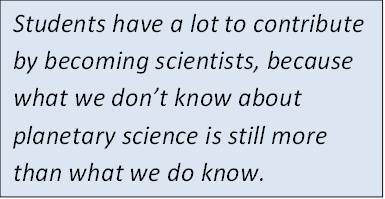 That will create an entirely new understanding of reality. It is a reality freed from the artificial boundaries of anthropocentrism. It is a reality full of unsolved mysteries about planetary science and our place in the cosmos. It is a reality where students have a lot to contribute by becoming scientists themselves, because we are communicating the fact that there is more we don’t know about our solar system than what we do know.
That will create an entirely new understanding of reality. It is a reality freed from the artificial boundaries of anthropocentrism. It is a reality full of unsolved mysteries about planetary science and our place in the cosmos. It is a reality where students have a lot to contribute by becoming scientists themselves, because we are communicating the fact that there is more we don’t know about our solar system than what we do know.
Students today aren’t getting that impression when we tell them there are exactly eight planets, all of them were discovered long ago, they orbit in these eight regular paths, and that’s that.
8. Pluto’s planethood conveys the excitement of discovery
Even beyond the classroom, the public will be gripped with the excitement of discovery when we acknowledge hundreds of planets beyond Neptune. Extending the horizons of our civilization wasn’t only for people who lived hundreds of years ago. One day – I think within a century (or certainly within two) – we will build scientific observatories and transportation hubs on these many worlds of the Kuiper Belt. Shoving them out from planet status has tended to push them from the public’s consciousness and thus it has reduced the excitement of discovery.
9. What Would Spock Say?
And finally, reason number nine: what would Spock say as his spacecraft approached one of these smaller, icy worlds of the Kuiper Belt? Or if you prefer, what would Skywalker say?
In other words, how do civilizations think of planets when they are no longer merely looking at them through telescopes, when they are traveling to them to live and to work? We are in the process of becoming a spacefaring species, and the perspectives of Spock and Skywalker will soon be our own. We will land on planets, establish outposts on them, grow food in their soil, and raise our babies on them. The planets of our solar system – including the Kuiper Belt – are destined to become ever more physical to us: the solid ground beneath our feet, not tiny points of light in the sky.  The IAU can’t claim the naming rights for everything in space when people live there. The skies won’t belong to the people with telescopes, but to the people with spaceships. They are the ones who will create the definition of a planet.
The IAU can’t claim the naming rights for everything in space when people live there. The skies won’t belong to the people with telescopes, but to the people with spaceships. They are the ones who will create the definition of a planet.
In Star Trek Enterprise there was an episode “Rogue Planet” about a world that did not orbit a star. The characters called it a planet, nevertheless. In Star Wars there was the ice planet Hoth that had not cleared its orbital neighborhood of the many asteroids. The characters called it a planet, nevertheless. Something inside us knows that a planet’s being will trump its doing when people experience it as a physical world.
What will your granddaughter say as she approaches Eris to repair its node of the observatory? What will your great grandson say as he approaches Pluto to check the progress of a robotic construction crew?
I think it will be something like this:
Sensors detect that we are approaching a planet, Captain.
Footnote: 1. This includes seven moons and one dwarf planet that are larger than Pluto, but Mercury is also smaller than some of the moons.

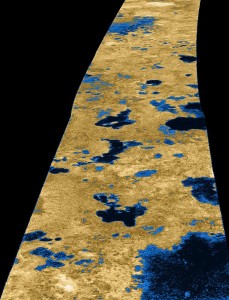
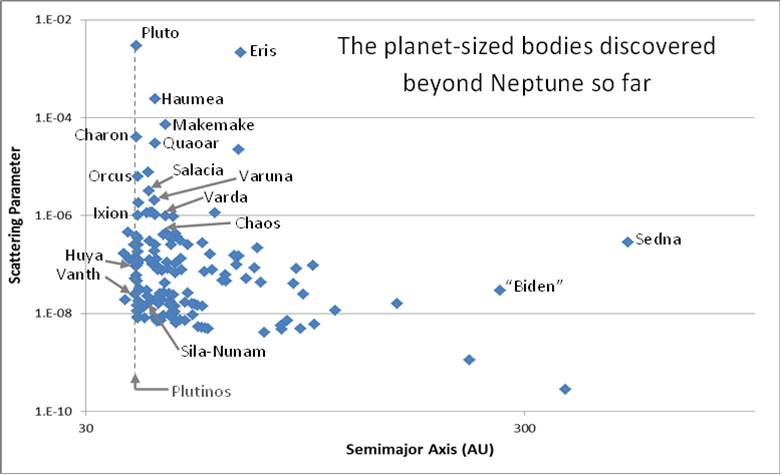
What a wonderfully written post! Great job Phil! I learned quite a lot from this and definitely have a new perspective on how we define Pluto. Cheers!
You’re absolutely right Phil, Pluto should be a planet, and so should every other chunk of ice and rock in the Kuiper Belt. Boy I hope those Rimans have a lot more gods.
I like your mission of bringing back my favorite childhood planet. Do be do be do bring back Pluto 🙂 CharlieThib.
No.
That’s not how any of this works.
Pluto is part of the kuiper belt, and has the same composition as everything else in the kuiper belt.
it can’t be a planet just because you want it to.
Up next: Nine Reasons Why Ceres Is a Planet!
As someone who has Clyde Tombaugh’s autograph, I am glad people are sticking up for Pluto.
This is a terrific article, with powerful, scientifically sound arguments as to why Pluto and all dwarf planets are planets. Yes, that includes Ceres, which is clearly in hydrostatic equilibrium. Interestingly, orbit sharing has been found in other solar systems. There are at least three known cases of two giant planets orbiting their stars in the same 3:2 resonance as Neptune and Pluto. There are also giant exoplanets with extremely elliptical, comet-like orbits; those who argue that a comet-like orbit makes an object a comet rather than a planet would have to classify these large planets as comets too!
The footnote erroneously claims one known dwarf planet is larger than Pluto. So far, this is not the case. Eris was initially thought to be larger than Pluto, but in 2010, a team of astronomers led by Dr. Bruno Sicardy obtained a more accurate measurement of its size when it occulted a star and determined that Eris is marginally smaller than Pluto though more massive.
In response to “the mediator,” Pluto does not have the same composition as everything in the Kuiper Belt. There are two types of objects in the Kuiper Belt. The overwhelming majority are tiny,shapeless, icy, cometary bodies. These are distinct from objects like Pluto that are small planets because they are complex worlds rounded by their own gravity. Objects in this second group have geology and weather and are layered into core, mantle, and crust. Pluto, unlike the first type of Kuiper Belt Objects, is estimated to be 70 percent rock. It has an atmosphere and possibly even a subsurface ocean.
We cannot classify objects solely by their location while overlooking their intrinsic properties. Kuiper Belt Objects large enough to be spherical are also small planets. One designation does not preclude the other.
So, according to your argument Titan and galilean moons are planets since they are bigger than Pluto, rounded and have a scattering value higher than 1? They just unfortunately orbit a planet, but at the end, its an equivalent aituayion as rogue planets…
I dont see the point in discussing a clasification criteria. It is just that. We need to do it in order to put order to chaos. You’ll always have border line cases.
Regards, Fernando
Hi mgrant! Not every chunk of ice and rock — only those that meet the geophysical definition of a planet. That eliminates the vast majority, just as it does in the Main Asteroid Belt.
Hi Laurel! Great comments. You raise some important points that I wish I had included in the post. (I will leave the footnote unchanged just for the moment until we get better measurements of Pluto during the New Horizons flyby. The two bodies are so close in size that we can’t say for sure which is larger. The purpose of the footnote was simply to answer objections if a reader forgets that moons are included in the list. If they forget that, they might wonder how I got this number of bodies larger than Pluto.)
Hi Fernando! Thanks for your question and comment. I didn’t really address whether moons should be considered planets or not, but I am planning to do that in a future post. The scattering parameter doesn’t apply to moons. I mentioned that in the figure caption. It was just (somewhat) interesting to see what their scattering parameter would have been if they had been at that distance from the sun and not orbiting a planet. But it’s actually a silly hypothetical point, because most of the moons formed in-place orbit around their planets, and the mass that went into the planet had to go somewhere so it wasn’t possible for one of those moons to form all by itself in that location of the solar system.
Besides, I’m arguing that we should use a geophysical classification system and not mix it with any dynamical requirements. I think dynamical classification should be a distinct system that is overlaid upon the geophysical classification system. So, if we adopt a purely geophysical classification, does that make the gravitationally-rounded moons out to be planets? Yes, it does. For a while that used to bother me. I felt that moons have to be separate from planets. Wasn’t the geocentric versus heliocentric controversy centered on the idea that planets go around the sun, not around another planet (the Earth)? Well, no, not really. The controversy was whether or not the Earth was a singular entity at the center of the universe. It was still OK to have planets going around other planets, according to the chief proponent of heliocentrism. When Galileo discovered the four largest moons of Jupiter, he started calling them ‘planets’. The fact that other planets orbited another planet rather than the Earth was one of his arguments to undermine geocentrism. Later, Huygens started calling the moons ‘secondary planets’ in contrast to the ‘primary planets’. (It was only later that people started calling them ‘moons’ in analogy to the Earth’s satellite, because it already had the name ‘Moon’.) This terminology is consistent with the original meaning of the word ‘planet’ — a body that wanders in the night sky relative to the background of stars. Moons do wander in a nested way. So after learning this, I became comfortable with using a purely geophysical definition of ‘planet’. A moon does indeed meet that definition so we can call it a ‘planet’, but we can subclassify it as a ‘secondary planet’. Some people prefer the terminology ‘planetary-mass body’ or ‘planetary body’ as the top-level classification, and then ‘primary planet’ (or just ‘planet’) and ‘secondary planet’ (or ‘moon’) become dynamical subclassifications.
Why not a variation on the H-R Diagram? Jupiter masses by diameter scale. Here’s a late-night scheme I came up with in a fit of pique:
Classification is not biased toward location in the Solar System or classical or colloquial nomenclature. A through C are all considered planets if primarily orbiting their sun (i.e. not orbiting another sub-stellar body). Moons are bodies orbiting planets, even if some (Ganymede, Titan, Luna) would be planets if freely orbiting the sun. I suggest the terms “Planet” and “Moon” be simply functions or locations, not a determining factor in a body’s part in the classification scheme.
A. Upper end of the scale:
Gas Giants: 13 Jupiter masses—the Super-Jupiters through Saturn masses. Excessive gaseous atmospheric hydrogen envelopes, probably metallic hydrogen cores. Highest densities, fewest quantities.
J13-J0.1
B. Intermediate:
Ice Giants: Super-Uranuses through Sub-Neptune masses. All bodies with predominating icy-gaseous atmospheric envelopes, probably rocky cores. Intermediate densities, medium quantities.
J0.09-J0.01
C. Medium:
Major Terrestrial Bodies, commonly called Rocky Planets: Super-Earths through Sub-Ceres masses, spherical moons, large Kuiper Belt objects. All bodies at least 300 km in diameter and capable of hydrostatic equilibrium. Medium densities, intermediate quantities.
J0.009-J0.0001
D. Lower:
Minor Terrestrial Bodies, commonly called irregular moons and asteroids, small Kuiper Belt objects, comets, Centaurs: Vesta masses through to the smallest coherent bodies, short of dust particles and detritus. Lowest densities, highest quantities.
<J0.00009
Left-edge scale: Jupiter masses (13.0- ~1.0-5)
Bottom-edge scale: diameters (largest-to-smallest; 150,000 km- <50km)
Or something along these lines.
Great points! I agree with you 100%. I wonder when we see Pluto-Charon, what if Charon is the planet and Pluto was its moon? I’m sure that is not the case as I am for Pluto being a planet and Charon too if it has an atmosphere. I can’t wait to see it. Your thoughts on Charon.
Hi Walt! Charon is surely large enough to be a planet according to the geophysical definition (i.e., that it must be rounded by its own gravity into hydrostatic equilibrium). And both Pluto and Charon orbit a barycenter that is located between them, not within either body. Therefore, it should be called a double planet system. Even with the IAU’s current definition of a planet, it should be called a double dwarf planet system. Maybe Charon will be given that status after we see it up close. It will certainly be an exciting time as we get the first close-up view!
I think a “planet” should be any spherical body with sufficient mass to undergo differentiation but not enough mass to initiate nuclear fusion and thus be classified a star. That’s a geophysical definition based on what the body “is” rather than what it “does.” There could be sub-types based on other characteristics, including dynamic ones. For example, we could define “primary planets” as planets that orbit the sun, “secondary planets” as planets that orbit other planets, “rogue planets” as planets that orbit nothing (ejected from solar systems). Maybe there’s a place for a category of planets that haven’t cleared their orbits too, but we that depends on where we catch the object in its lifecycle, as well as other details of the planet’s orbital parameters in relation to its central body. I don’t think the term” dwarf planet” would necessarily be appropriate in this case since even large planets may not have cleared their orbits yet early in their life cycle. We could have other classification schemes based on composition (gas giants, terrestrial, icy, etc.) too. Still, a planet is a planet regardless of the type. After all, “what would Spock say?”
Interesting article and several valid points, but I don’t see where Pluto’s orbit is addressed. It’s tilted to the plane of the solar system and from 1979 to 1999 it crossed Neptune’s orbit.
Hi Dewey,
I will discuss its orbit in an upcoming post. It was (apparently) scattered and captured into its present orbit by Neptune at a time when Neptune was moving outward. When Neptune scattered Pluto, that put Pluto into the more tilted, eccentric orbit. Many of the other Kuiper Belt objects were similarly scattered. While it’s orbit is different than those the eight classical planets, there’s no reason a priori to say that bodies with elliptical or tilted orbits cannot be planets. They are just different. Many of the exoplanets that are being discovered are also in more eccentric orbits than the classical planets of our own solar system, and yet they are still planets. We have learned a lot in the past 10 years, which puts Pluto into a whole new perspective.
since pluto and neptune pass each other, heres one i thought, isnt neptune, not shot out the other things in, its path? yet and it needs to shoot out pluto, and it isnt a planet? neptune or pluto one need to shoot each other out of its orbit. one or the other.
“My Very Educated Mother Just Showed Us Nine Planets”
They teached me that saying when I was a child. (The German Version of it: “Mein Vater Erklaerte Mir Jeden Sonntag Unsere Neun Planeten”)
So for me Pluto has been always a planet, is a planet, and it will be a planet in the future to me.
Everything else is nonsens!
Here is a logarithmic graph of the masses of major solar system objects as a ratio of the Earth’s mass:
https://upload.wikimedia.org/wikipedia/commons/5/56/Graph_showing_relative_masses_2.png
Considering that mass is probably the most meaningful metric when physically “ranking” solar system objects, this graph provides an interesting perspective on things. Notice where the gaps are. Outside of the significant differences between the classical planets, the biggest gap on the chart (by far) is immediately below Pluto, which corresponds to a cutoff point of 0.001 of an Earth mass. Also, the other three significant gaps further down the list are all adjacent to objects of great current interest, namely Ceres, Vesta and Enceladus.
Perhaps we should end the debate and strike a compromise with the other side based on a blatantly arbitrary aspect of our own solar system – the significant mass gap between Pluto and everything less massive. I, for one, would be delighted to suddenly have 17 planets on the roster, including incredibly dynamic worlds such as Io, Titan and Europa (and maybe Pluto!). And there is not much excitement happening in that mass regime below Pluto, anyway (Enceladus being the exception that proves that rule, of course) – everything’s pretty much cold and dead, dynamically speaking.
Food for thought.
Now, tell us why Pluto should qualify as a planet and not Charon?
You forgot to talk about the elephant in the room: nobody would have discuss this topic and IAU vote if Pluto wasn’t an american discovery. Anytime someone mixes science with patriotism, we’re all falling into bad science. Pluto is not a planet because there are countless comparable objects around the Sun and we must draw the line somewhere. Period. A grain of sand orbiting the Sun would also be a planet otherwise. Also, we have a pretty good idea of the 8 planets’ origin, but the Pluto-Charon complex seems to have a different (still unexplained) origin. That’s enough reason for me.
That being said, I agree that rogue planets should be re-categorized, unless we can prove they were former ordinary planets ejected from their original star system a long time ago.
Did not convince me, sorry. I would love Pluto to be a planet of the solar system, that’s what I was taught when I was a kid and it’s the only ss planet that we have discovered. But unfortunately, it’s not. No need for 9 points, just look at the solar system and a little common sense.
Hi Norman (normandrivard),
I completely agree we need to draw a line somewhere because a dust speck is not what we mean by “planet”, but “clearing the orbital neighborhood” is not the right way to draw that line. It produces absurd results when we compare with other solar systems. Also, bodies can get flung around so they don’t orbit the same body or in the same distance from their star during their entire existence; therefore, dynamical considerations are more of an occupation of a planet, not what the body actually is. It doesn’t make sense to base the primary classification of physical objects on something so changeable. Triton, for example, is right now a moon of Neptune, but previously it orbited the sun like Pluto. It can be classified dynamically as a moon in its present state, but that’s not a description of what it essentially is. A better way to draw the line would be based on the body itself, not on its dynamics. Here’s a blog post where I talk about the way to draw this line between a planet and something smaller than a planet: http://www.philipmetzger.com/blog/how-big-is-a-planet/
Classifying the dynamical state of planets and moons is important because it will allow us to classify solar systems themselves: some solar systems will have certain types of belts where no one planet dominated; perhaps others will have belts that are different. Thus, dynamical definitions may tell us essentially what the different solar systems are. However, I don’t believe they tell us essentially what the individual bodies in that solar system are. Therefore, the classification system that says “Pluto is not a planet” is unhelpful to science and was a mistake. I have no doubt the mistake will be corrected eventually, because the absurdity of it can’t survive forever.
Hi Andrew,
I could never tell you that because I fully believe Charon should be classified as a planet along with Pluto 🙂 They are a true double-planet system.
Hi Chris,
interesting observation, but I think it’s important that we develop classification that work for more than just our own solar system. We are getting such a wealth of exoplanetary data now, the field of planetary science is just now coming into its heyday and so it will be impossible to use terminology we developed during our limited, Earth-centered experience much longer.
Hello ldrancer420,
That’s true! Also, Earth has not completely cleared its orbit, nor has Jupiter nor any of the classical planets. Clearing an orbital neighborhood is never truly completed. Someone will argue that the definition of “clearing the orbital neighborhood” can be made more precise (and it can be), yet no matter how we improve it, it still misses the main point of what planets are. Dynamical considerations don’t tell us what a body is, and therefore it isn’t a useful way to classify and discuss them. (It is useful for discussing the nature of solar systems, however.) A body that is exactly like the Earth can exist around a star that is larger than the sun where it cannot clear its orbit. So the Earth and this Earth-like body should be compared and studied and discussed together, but according to the current (silly) definition we can’t call them both “planets”. This muddled terminology will make it more difficult to discuss them together. Someone might try to argue that it is good that we can’t use the same terminology for these two bodies, because if the one hasn’t cleared its orbital neighborhood then it will be hit with more asteroids and that will fundamentally change what happens on that body, so it should be called something different than “planet”. Well, that is simply not true. Pluto has not “cleared its orbital neighborhood” but it does not get hit by asteroids at a much different rate than the Earth does. The reason bodies like Pluto can’t clear their orbits is because they are so far from the sun where there is a lot more space, and thus the bodies never interact with each other. They never fling each other away for the same reason that they never collide. An Earth-like planet around a larger star will fail to clear its orbit precisely because it will not collide with the other bodies that are in its neighborhood. Therefore, its experience and its evolution as a planet will be exactly like the Earth’s. Clearing or not clearing the orbit has hardly any effect on the planet. So really they are both the same type of body and should be classified as the same type of body.
What you have pointed out helps to make this case. Pluto and Neptune do not fling each other away. They are in resonance so they now evolve without interfering in each others’ processes.
Hi Dewey,
thanks, and apologies for the delay in replying. I’ve now addressed it in an additional post, here: http://www.philipmetzger.com/blog/planet-tossing-and-the-kuiper-belt/
Norman says: “We must draw the line somewhere. Period.”
That sounds like a quite arbitrary proposition, put that way.
No one is proposing pebbles in space as planets. Simply stripping out the third test from the IAU definition, leaving us with objects large enough to have achieved hydrostatic equilibrium (i.i., they are round – which generally rules out anything smaller than a few hundred km in diameter) and not so big as to undergo nuclear fusion leaves us with a very simple test that has solely to do with intrinsic properties – nothing about where the planet happens to be.
Yes, that almost certainly means we have a couple hundred planets. So what? There’s nothing to say we can’t have further categories of “planet.”
Hello Phil,
This was a great essay – you have done a great job making the case.
“I could never tell you that because I fully believe Charon should be classified as a planet along with Pluto 🙂 They are a true double-planet system.”
I think, once you accept this case, you really cannot say that moons which have achieved hydrostatic equilibrium aren’t planets as well. So, the Moon, Titan, Europa, Charon and Callisto are planets under this definition, but Phobos, Thebe, Hyperion and Styx are not. These are planets acting as moons; but in their intrinsic qualities, they are not fundamentally different from other rocky planets.
If Pluto is a full planet, then so are Ceres, Eris, Haumea, Makemake, and possibly over 100 others. That’s gonna be a helluva mnemonic to teach elementary school kids.
Hello Alex,
Kids love a challenge.
But I don’t think anyone is seriously arguing that the memorization skills of schoolchildren should dictate our planetary categorization.
Under the Stern/Metger (if I may call it that) definition, there are almost certainly over a hundred planets in the Solar System, perhaps even several hundred – most of them Kuiper Belt or Scattered Disk planets. If so, it just goes to show that we’re learning that there is far more to the Solar System than we ever dreamed. And that’s exciting.
Hi Richard (richardmalcolm1564),
I agree, and there is excellent reason to say larger moons are planets. First, Galileo discovered the four largest moons of Jupiter and he called them planets. Christian Huygens called them “secondary planets”, i.e., planets that orbit primary planets. Second, planetary scientists today still call them planets in everyday work and in conferences. Third, some planets like Triton once orbited the sun and were later captured as moons, while some moons may be ripped loose through encounters with other bodies to become primary planets. So the distinction between primary and secondary planets is more like an occupation than a physical existence. This is true of all dynamical categories. Dynamical classifications are important but they tell us about the history of the solar system more than they tell us about the nature of the individual bodies.
The arguments in favor of Pluto being a planet presented here are really quite strong. Too bad there are still some ‘earth is flat” people who won’t even entertain some of the very good facts presented on this website. For me though, this definition is enough: “A planet is “the smallest spherical lump of matter that formed around stars or stellar remnants.” Therefore, Pluto is a planet. The IAU is wrong…how do we know this? Well, everyone accepts that the earth is a planet right? What if the earth was impacted by another body which knocked it into an irregular orbit like Pluto? Would the earth still be a planet, even if the orbit was elliptical? Of course, so the IAU’s definition of “planet” would be wrong for this reason alone.
I think IAU decision is another example of PC run amok. They don’t like Pluto because its the ONLY planet discovered not discovered by an American. If you think there’s no bias because of this, you don’t understand human nature.
Hello Steve,
I think certain people at the IAU in 2006 were confronted with the growing reality that, with the discovery of Eris, Makemake, Sedna et al that there was a good probability that there were literally hundreds of planets in the Solar System under the prevailing definition – and that made them uncomfortable. That the overwhelming majority of “planets” in our system might well be flash-frozen icy rockballs 300-1200 km in diameter, drifting about in strange orbits in the dark vastness of trans-Neptunian space.
But why should such a prospect make us uncomfortable? Yes, it means that planethood and our Solar System are messier, vaster and more complex realities than we imagined. And there’s no reason we can’t come up with sub-classifications of planets – we do it for stars, after all.
I can’t speak to the possibility of anti-American sentiment driving the decision, however.
You left out one thing : Planets get observed more. Pluto was observed astrometrically from the time of its discovery, because it was a planet. James Christy worried about bumps on its images (and found Charon), because it was a planet. For that matter, New Horizons was built and launched to Pluto… because it was a planet. Eris is not a planet; where is the push to send a probe to it?
These labels matter and have consequences, so we need to get them right.
I also wish people wouldn’t forget about nomadic planets – microlensing indicates that there are more nomadic planets than stars (and, probably, than planets orbiting stars). A nomadic “Earth” or “Jupiter” is for sure a planet, even if it has no fixed addressed.
Starting a social media campaign to reinstate Pluto as a planet. All support welcome!
This totally helps, in my English class, we are currently on debate, and I am on the affirmative side of should Pluto be a planet, and I speak fast, so to do it in the correct amount of time, I had to add information, and I found good information that I didn’t find anywhere else on this page. Thanks!!
How to define what a planet is:
Step 1: Define the minimum dominant mass (MDM) of a solar system
The mass of the smallest rounded celestial body in orbit around a star (or stellar remnant) that has cleared the neighborhood of [or is dynamically dominant in] its orbit using Jean-Luc Margot’s planetary discriminant (where Π ≥ 1).
For example, for our solar system Mercury is the MDM; in the solar system known as Kepler-37, the MDM is Kepler-37b (which has a diameter slightly greater than Earth’s moon). See the following link for a more technical explanation of Margot’s practical planetary discriminant:
http://mel.ess.ucla.edu/jlm/publications/Margot15.aj.PlanetDefinition.pdf.
Step 2: Define the term planet
A celestial body that…
(1) orbits one or more stars or stellar remnants;
(2) is a gravitationally dominant member of its solar system, defined as follows:
(a) has cleared the neighborhood of [or is dynamically dominant in] its orbit (e.g., Margot’s Π ≥ 1)
OR (Note: Skip 2b if 2a is already fulfilled, for example, to expedite exoplanet classification.)
(b) has a mass >= the MDM of its solar system;
(3) has a mass below 13 Jupiter masses, a nominal value close to the limiting mass for thermonuclear fusion of deuterium.
With this definition, as long as Earth and Jupiter orbit the sun directly, they will always remain planets regardless of their hypothetical location in the solar system (e.g., a “remote” Jupiter that orbits in the Oort Cloud or a “remote” Earth” that orbits at 100 AUs from the the sun). And with this definition, you don’t set an arbitrary cut-off point for planethood for all other solar systems at Mercury but instead use a contextual cut-off point for planethood unique to each solar system (as in the case of Kepler-37).
Everything less than the MDM will be a dwarf planet or small solar system body (SSSB, or sub-planetary mass object) so there won’t be any more Jupiter-like planets potentially mislabeled as “dwarf planets” because of their given location within a solar system. Rogue planets and large rounded satellites will remain separate categories under the classification of planetary mass objects (PMOs).
In summary, planets are by all rights the dominant players of any given solar system (after their parent star(s) of course). Dwarf planets, large rounded satellites, rogue planets, and SSSBs are, for various reasons, not dominant players of solar systems.
ccccccooooooooollllllllllll
Pluto is a planet.
EVERYONE!! Planets have feelings too you know!
Should Pluto be a planet.
This is hands down the most comprehensive collection of arguments for Pluto’s planetary status I’ve found. I also like the tone that was struck – serious, grounded and slightly barbed at the IAU, as is deserved.
I’m somewhat surprised that the disingenuous way in which the IAU came to that particular vote wasn’t addressed but I understand this needed to be an argument FOR Pluto’s status rather than AGAINST an organizations entrenched biases (though there were references to that elitism).
Thank you for this piece.
All of your points do not adress the issue of coming up with a way to categorize planets and non planets. In fact most of your arguments are political in nature and you want to manipulate people into thinking an object isn’t interesting just because it’s not called a planet. Bringing size into the issue doesn’t help. Just because you quote someone saying it’s too small doesn’t mean that’s the issue. He’s a whale is a mammal and so is the smallest rodent. But they have genetic markers so size goes out the door there. If animal has mammary glands it’s a mammal. End of story, size matters not. I think this does more positive for science then negative. It shows what science is supposed to be about. We discover an issue with the term planet. A set of guidelines is set up to the best of our abilities to categorize objects (because scientists tend to do that for god reasons) and Pluto didn’t make the cut. Showing that science doesn’t care what you believe. The good thing about science is it’s the truth whether one wants to bekueve it or not. This extends into other areas where humans don’t predefine what makes an object as well. It shows that scientists should admit they were wrong based on new data and change things (in this case changing Pluto into a dwarf planet, which makes it no less interesting to anyone with intelligence). If it does make that big of a difference than I have to wonder if I want that person on mundane team when they give in to passion more than reason and logic.
well written
Pluto is my fav.PLANET!!!!!